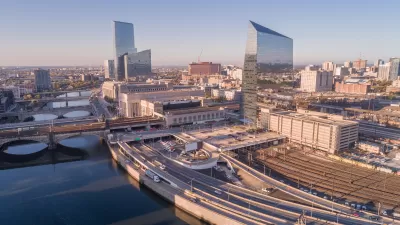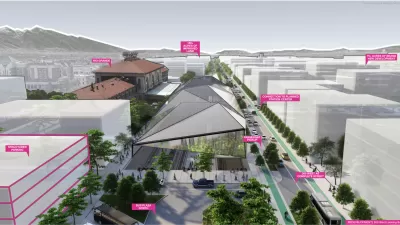As the 100th anniversary of its opening approaches, The New York Times recounts the birth of one of the finest railway stations in the world - Grand Central Terminal.
The "product of local politics, bold architecture, brutal flexing of corporate muscle and visionary engineering," Grand Central Terminal officially opened to the public in February 2, 1913 after 10 years of construction. The Times excerpts the story of the $2 billion (in today's dollars) terminal's birth from “Grand Central: How a Train Station Transformed America,” by Sam Roberts.
Among the most radical of the terminal's innovations in replacing the former Grand Central Station was that by accommodating electric trains, rather than steam locomotives, "[t]he 'veritable Chinese Wall’ that bisected the city for 14 blocks could be eliminated. The air above the yards could be magically transformed into valuable real estate in the heart of Manhattan."
Though a decade and millions of dollars were spent constructing the station's various feats of engineering, no expense was spared in accommodating the station's passengers either. "When it was finally completed, Grand Central could boast a separate women’s waiting room with oak floors and wainscoting and maids at the ready; a ladies’ shoe-polishing room 'out of sight of the rubbernecks' and staffed by 'colored girls in neat blue liveries'; a telephone room for making calls; a salon gussied up with walls and ceilings of Carrara glass, 'where none but her own sex will see while she had her hair dressed'; a dressing room attended by a maid (at 25 cents); and a private barbershop for men, which could be rented for $1 an hour, and a public version where 'the customer may elect to be shaved in any one of 30 languages.'”
"When Grand Central was finally finished, the only thing lacking was adjectives. The Times produced a special section of the newspaper and hailed the terminal as 'a monument, a civic center, or, if one will, a city.'”
“Without exception,” the newspaper said, “it is not only the greatest station in the United States, but the greatest station, of any type, in the world.”
FULL STORY: 100 Years of Grandeur

Planetizen Federal Action Tracker
A weekly monitor of how Trump’s orders and actions are impacting planners and planning in America.

Maui's Vacation Rental Debate Turns Ugly
Verbal attacks, misinformation campaigns and fistfights plague a high-stakes debate to convert thousands of vacation rentals into long-term housing.

San Francisco Suspends Traffic Calming Amidst Record Deaths
Citing “a challenging fiscal landscape,” the city will cease the program on the heels of 42 traffic deaths, including 24 pedestrians.

Amtrak Rolls Out New Orleans to Alabama “Mardi Gras” Train
The new service will operate morning and evening departures between Mobile and New Orleans.

The Subversive Car-Free Guide to Trump's Great American Road Trip
Car-free ways to access Chicagoland’s best tourist attractions.

San Antonio and Austin are Fusing Into one Massive Megaregion
The region spanning the two central Texas cities is growing fast, posing challenges for local infrastructure and water supplies.
Urban Design for Planners 1: Software Tools
This six-course series explores essential urban design concepts using open source software and equips planners with the tools they need to participate fully in the urban design process.
Planning for Universal Design
Learn the tools for implementing Universal Design in planning regulations.
Heyer Gruel & Associates PA
JM Goldson LLC
Custer County Colorado
City of Camden Redevelopment Agency
City of Astoria
Transportation Research & Education Center (TREC) at Portland State University
Jefferson Parish Government
Camden Redevelopment Agency
City of Claremont




























